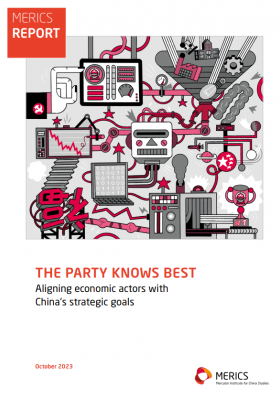

MERICS China Security and Risk Tracker 02/2024
Rising tensions in the South China Sea: risks and implications for Europe
Tensions are mounting in the South China Sea again. The Philippines under President Ferdinand "Bongbong" Marcos is trying to turn the tables on China with a new strategy of publicizing China’s actions and collaboration with allies, particularly the United States and Japan. Beijing is bristling at its success and responding with increased aggression. China Coast Guard vessels caused two collisions with Philippine ships in March during a mission to resupply a Philippine vessel, injuring four crew members.1 And in one of the most recent and worst flare-ups of violence, the China Coast Guard rammed and intercepted a Philippine Navy resupply mission, then proceeding to board the Philippine boats, armed with knives. The skirmish caused injuries among Filipino personnel and damaged some of the Philippines’ ships, which China then seized and tried to tow away.2 Manila promptly released videos of these incidents.3
The situation in the Taiwan Strait will continue to pose serious challenges to regional stability as China attempts to intimidate the new government of President Lai Ching-te of Taiwan’s Democratic Progressive Party (DPP) and to reestablish its red lines. But the South China Sea could pose greater short-term risks to international actors. Tensions in the region have ratcheted up as the Philippines and China face off, though their dispute has garnered far less international attention. It is a volatile situation in which escalation seems a distinct possibility. Manila’s renewed engagement with partners creates opportunities for Europe, but dangers too.
Tensions flare over the Sierra Madre
China and the Philippines have been clashing over the Second Thomas Shoal in the Spratly Islands for the last year. The shoal lies within the Philippines’ 200-mile Exclusive Economic Zone (EEZ). However, China lays claim to it. The Philippines maintains a small military contingent there, onboard a now crumbling ship – the BRP Sierra Madre – which Manila intentionally grounded in 1999 to reinforce its control of the area.
What for decades was a manageable issue for both sides, has now become the focal point of China-Philippines tensions. Relations soured between Manila and Beijing after Marcos took power in 2022 and abandoned his predecessor Rodrigo Duterte’s more China-friendly stance. This translated into a rapid increase in harassment and aggression against Philippine activities in the South China Sea. Manila’s monthly resupply missions to its marines on the Sierra Madre, which had long taken place without too much pushback from Beijing, became a target. Claiming to be repulsing the Philippine’s attempts to repair the ship and keep it grounded for longer, China’s Coast Guard has repeatedly used water cannons and other aggressive tactics against Philippine ships, causing a few collisions and injuries.
Beijing has tried to shift blame for the tension onto Manila, accusing the Philippines of ignoring a “gentleman’s agreement”4 it had with former president Duterte. Beijing has announced it is willing to allow Manila to continue resupplying the Sierra Madre with the necessities – but only if Manila seeks permission in advance,5 a non-starter for the Philippines as it would amount to a tacit acknowledgement of China’s sovereignty.
Beijing’s tactics are backfiring
Beijing’s intimidation attempts have not had the desired effect. China’s leadership seemed to expect Manila to back down if they applied enough pressure. Instead, the Philippines has adopted a new strategy to resist and fight back against Chinese aggression, using greater transparency and not shying away from confrontations at sea. Manila now regularly denounces and publicizes China’s actions – shining a spotlight on Beijing’s operations by releasing videos of encounters with Chinese Coast Guard ships and inviting international journalists onboard its own vessels. These moves have taken the initiative and narrative control away from Beijing. China’s Minister of Defense, Admiral Dong Jun, has lashed out against the Philippines’ creation of “false scenarios to mislead the public”,6 giving a clear sign this strategy is hitting China where it hurts.
Criticizing China for unsafe maneuvers and aggressive behavior has helped raise awareness among the Filipino public. It has also rallied international support in an unprecedented way. China’s coercion – a shared concern for many regional actors – has given momentum to Manila’s efforts to deepen its relations and security cooperation with partners, both regional and global. In April, the Philippines, Australia, Japan and the United States conducted their first-ever joint patrol within the Philippines’ EEZ in the South China Sea.7 A few days later, Marcos attended the first ever US-Japan-Philippines trilateral summit in Washington. There he secured some economic and military support and a key statement of support from President Biden. “Any attack on Philippine aircraft, vessels or armed forces in the South China Sea”, he said, “would invoke our mutual defense treaty.”8
Armed with this support, Manila is now ratcheting up its rhetoric too. In clear warnings to Beijing, President Marcos has called for Filipino soldiers to be ready for conflict. He told the Shangri-La Dialogue (31 May-2 June) that any willful incident resulting in Filipino loss of life would be a “crossing of the Rubicon” and likely seen as an act of war.9 As the Philippine’s defense secretary Gilbert Teodoro said, China has become an “existential threat” in the South China Sea.10
US backing and greater alignment with, and support from, other partners like Japan or Australia, shows the success of the Marcos administration’s new strategy to stand up to China. It enables the Philippines to stay the course and resist Chinese pressure, as well as helping deter some of China’s worst impulses by clarifying red lines and likely responses. And the Filipino public seems to favor pushback: 73 percent of adults polled in a recent survey expressed support for military action to resist China’s behavior.11
Manila’s international outreach and focus on deterrence creates opportunities for Europe to step up its Indo-Pacific presence and engagement. By continuing to support Manila, Europe can show itself as a consistent, reliable partner to regional actors. Coordination with Tokyo, Washington and other regional partners to push back against China’s assertive behavior and defend international law could allow Europe to expand its impact without acting alone.
Risk of escalation increases
However, deterrence might not be enough to prevent escalation as there is little sign that Beijing intends to change course. It has put itself in a difficult position. For domestic and geopolitical reasons, it is highly unlikely to offer any concessions that might damage the Chinese Communist Party’s (CCP) image as defender of China’s sovereignty and national security or its goals of turning China into a regional and global powerhouse by 2049. But at the same time, Beijing is keenly aware that pushing its territorial claims through military means is driving the Philippines and other regional powers closer to the United States and also increasing the risk of military escalation.
Beijing seems to be trying to modulate its approach to avoid losing control of the situation, while keeping the general lines untouched. It is trying to mirror elements of the Philippines’ new transparency strategy, releasing its own videos and statements after incidents. It has even threatened to release a supposed recording of a phone call between a Philippine vice admiral and China’s defense attaché in Manila that it says confirms the existence of a “gentlemen’s agreement” about the Sierra Madre.12 Beijing is also trying to spin the narrative (especially with other countries in the Indo-Pacific and Global South) that it is the Philippines that is violating international law and stoking tensions, and that Manila is nothing but a pawn of the United States. China, the argument goes, only seeks stability in the region and it has never created any obstacles to freedom of navigation. After all, about one third of global shipping regularly traverses the South China Sea without issues.
Neither party is seeking to provoke an open war which would have catastrophic economic and geopolitical consequences regionally and globally, on a similar scale to a war in the Taiwan Strait. Yet the rapidly accumulating tensions, increasingly defined positions, heightened military activity and more intense Chinese harassment could easily lead to an accidental escalation that might draw in the United States and other powers. Tensions will only be exacerbated by China’s introduction in June of new regulations empowering its Coast Guard to detain foreign actors for “trespassing” in the South China Sea territories it claims, and by the PLA Navy’s first ever exercise inside the Philippines’ EEZ.13 Potential trigger points abound in the short term – they include the moment when the BRP Sierra Madre finally disintegrates, the US elections and possible subsequent shifts in US policy. Any doubts about Washington’s commitment to defend the Philippines could both embolden Beijing and weaken Tokyo’s resolve to step into a conflict.
Europe should keep a close eye on developments in the South China Sea and on broader regional trends beyond the Taiwan Strait tensions. Europe’s military contributions are and will be limited. However, Europe can still play a role in strengthening deterrence and seeking to prevent escalation. Increasing transparency over red lines and core interests, outlining the consequences of certain Chinese actions, and speaking out in support of international law, and against China’s harassment, are good places to start.
Top China Risks 2024
The likelihood or probable impact of some of the top China risks for 2024 which MERICS identified at the end of 2023 continues to shift. There is continuity in that the US presidential elections in November remain a key risk. Equally, Russian President Vladimir Putin’s visit to China in May underlined how China-Russia coordination has created serious, lasting challenges. However, other risks have become more urgent for European stakeholders, especially as EU tariffs on Chinese EV imports and the June European elections have shifted the dynamics. Below, we outline some key developments that have altered our risk assessments.
China’s overcapacity problem continues to grow, driven by heavy over-investment in its already massive manufacturing base. Despite the economic downturn, Beijing is consciously choosing not to direct resources towards boosting consumption but is instead funneling them into industrial policy. Today, China accounts for just over 30 percent of global manufacturing, but just under 20 percent of global GDP. The continuous growth in fixed asset investment into manufacturing will worsen that imbalance.
Historically, China’s over-production was largely tolerated when it spilled over into European and other markets, as it was only disruptive to a few lower-value manufacturing industries. Now, however, China’s economic model is distorting more significant markets; it is already crowding out competition in green energy tech like solar panels and wind turbines and beginning to undercut pricing in the automotive sector.
In response, the European Commission released the findings of a probe into subsidies and other state support in China’s EV exports to the EU, with the current tariff rate of 10 percent being increased by an additional 17.4 percent for BYD, 20 percent for Geely, and 38.1 percent by SAIC, with other cooperative EV makers being subject to a 21 percent weighted average duty and all non-cooperative EV makers being hit with a 38.1 percent rate. These are provisional for now, and the final rates that are expected in November will be tailored to further samplings of cooperative firms, including German brands and Tesla.
Beijing has signaled three main areas of retaliation: agricultural products, automobile exports, and aircraft sales to China. Not all these threats are equally credible. The agricultural sector seems a likely target; lower pork imports could shore up currently struggling domestic producers and Beijing is not bothered about middle class consumers eschewing more expensive European dairy products. It also sends a message to Europe, especially major pork and dairy exporters like France, Spain, and the Netherlands (all of whom have done something Beijing dislikes in recent months). Beijing has announced that it is currently reviewing complaints from domestic industry that European pork and dairy producers are dumping products in China, hurting local firms.
Threats against the EU’s automotive exports have been contained to cars with engines over 2.5 liters. Specifically, tariffs may be raised on them from 15 to 25 percent. European exports might suffer somewhat as a result, but the steadily shrinking number of cars exported to China (especially with larger engines) are increasingly limited to high performance, SUV, and luxury models. Chinese consumers who can afford those higher-end models are unlikely to be deterred by a small bump in tariff rates, but Beijing will be able to argue at home that it has retaliated.
Finally, Beijing’s threat to have its airlines reconsider ongoing talks with Airbus to purchase 100 jets, on the other hand, is less credible. Airbus’s backlog of more than 8,500 jets means it would feel scant impact if the list failed to grow by 100 more.
It is unclear if this will become a trade skirmish limited to a few product categories or develop into a broader trade war. The European Commission has a variety of ongoing investigations and probes that could trigger more clashes, ranging from medical device procurement to airport security scanners to steel pipes to Lysine – a food additive. Beijing has recently expanded its own trade war arsenal and can be expected to respond, given its history of economic coercion. At time of publication, the EU and China are opening negotiations on the EV tariffs, though it remains unclear if sufficient progress will be made on the underlying issues to assuage European concerns.
The anxieties of some EU exporters bracing for Beijing’s retaliation against the EU’s efforts against China’s exports of its own overcapacities have taken the spotlight off China’s ability to choke off critical supplies. However, China’s dominance across critical mineral supply chains remains a top risk for Europe as it scrambles to “de-risk” from China in the production of key digital, green and defense technologies.
Export controls have become a useful tool for Beijing to hit carefully chosen targets, while collecting industrial and supply chain intelligence. China’s licensing regime is extremely opaque, so tracking the impact of its export controls is difficult. However, trade data reveals that the Netherlands, the United States and Japan are no longer getting any unwrought gallium and germanium, or phosphides, from China. In August 2023, Beijing began license requirements for exporters of some gallium and germanium products and compounds, in response to restrictions targeting China’s semiconductor industry. Sweden had a similar experience from 2020 to end 2023 with graphite inputs used for battery production.
Europe’s reliance on China for critical minerals is an immense strategic and economic security risk. The European Critical Raw Materials Act, which the Council adopted in March, aims to boost resilience and reduce exposure to geopolitical shocks along value chains. New partnerships are being rolled out with resource-rich partners, such as Angola and Chile. For green industries, the Net Zero Industry Act and its recommended resilience criteria for public procurement, will further enable public authorities to divert supply from China. Against this backdrop, China will continue to use its leverage to make de-risking as difficult and costly as possible to defend its indispensability in multiple supply chains.
The outcome of the European Parliament elections in June suggests continuity in Europe’s China policy agenda over the next five years. Despite strong performances by far-right parties in several countries, the distribution of seats across the chamber will most likely allow a continuation of the current political alliance that supported European Commission president Ursula Von der Leyen’s previous mandate, though with a shift towards the center-right.
China is viewed as a challenge by the five biggest political groups of the last mandate (EPP, S&D, Renew, Greens, ECR), so they will support continuing with the EU’s de-risking agenda. However, the agenda is likely to emphasize economic risks from China over values-related concerns, given that the elections have increased the EPP's numbers amid losses suffered by Renew and the Greens.
Even if the overall direction of EU China policy is likely to remain consistent, the European poll’s outcomes may impact its implementation. Von der Leyen has been a key proponent of de-risking. Her reelection to lead the Commission is likely, but remains uncertain. Long or difficult negotiations could worsen divisions among member states. Furthermore, President Emmanuel Macron’s decision to call snap legislative elections in France could, if his gamble fails, alter China policy in a key member state and hinder progress in Brussels.
President Macron has strongly supported a more assertive European stance on China, while attempting to build personal rapport with President Xi Jinping. He has supported trade investigations into Chinese imports, and recently voiced stronger concerns about China’s support for Russian war efforts against Ukraine. France’s far-right parties, which made strong gains in the European elections also voice support for such trade investigations, including the probe into Chinese EVs. Yet, their warmth towards Russia and scant enthusiasm for boosting Brussels’ geopolitical competences would impact the de-risking project if they emerge victorious in France’s snap elections to the National Assembly.
The influx of parties and individuals new to the European Parliament also carries risks to European unity. Beijing may well seek to engage newcomers in order to expand its influence, as they are likely to have less experience engaging with foreign counterparts.
CHINA’S SHIFTING REGULATORY ENVIRONMENT
The second quarter of 2024 has brought changes to China’s regulatory environment that will affect actors with a presence there. This section analyzes some key developments international actors should consider.
Hong Kong arrests reflect erosion of rule of law
Rule of law and civil rights in Hong Kong are under more pressure than ever since the city’s legislature passed the “Safeguarding National Security Ordinance” in March. At the end of May, a court found 14 out of 16 democracy activists guilty of subversion in a landmark national security trial. Ahead of the 35th anniversary of the crackdown on the Tiananmen Square protests, six people were charged for “inciting hatred” against the government by sharing posts commemorating the events of 1989. On June 4, an artist was arrested for painting the number 8964 in the air.14
New limits on freedom of expression specifically target “soft resistance”,15 i.e. the use of artistic creations to question state power. There are global implications. A Hong Kong court issued an injunction in May requiring international media platforms such as YouTube to remove the pro-democracy anthem “Glory to Hong Kong” from the internet. Ten months earlier the city’s High Court had denied the request due to the potential impact on freedom of expression.
Hong Kong’s government is eager to signal it is “business as usual” and that the city provides international stakeholders with a secure investment environment. But civil society crackdowns are often a precursor to greater arbitrariness. Three international judges from the UK and Canada recently resigned from serving in the Hong Kong courts; one pointed specifically to the darkening political mood and its impact on judicial independence.16
Looking forward: What to watch in the months ahead
- July 3-4: Kazakhstan will play host to this year’s Shanghai Cooperation Organization (SCO) summit. The gathering will focus on SCO members’ key security concerns, including the situation in Afghanistan. The summit will provide yet another opportunity for the Chinese and Russian presidents to showcase their partnership. Belarus may be admitted as a full member during the summit.
- July 9-11: The annual NATO summit will be held in Washington. Russia and the war in Ukraine will remain top of the agenda, but China, and NATO’s relationships with its Indo-Pacific partners (the so-called AP4) will also feature prominently. The summit is expected to announce a handful of concrete cooperation projects with the AP4 which are the product of long negotiations.
- July 15-18: The long-awaited Third Plenum of the CCP’s Central Committee, which only takes place every five years, has finally been announced for July. The closed-door meeting of the topmost officials and party members from across China is normally when the party announces its economic program for the next few years, so observers will be watching for major reforms to tackle China’s socio-economic stress factors.
- September 10-24: The 79th session of the UN General Assembly will open in mid-September in New York. Ukraine and Gaza are likely to dominate the discussions, providing Beijing with rhetorical ammunition to criticize the West and shore up ties with Global South nations.
- Endnotes
1 | https://news.abs-cbn.com/news/2024/3/5/-ph-vessel-sustains-minor-damage-after-collision-with-china-ship-1018
2 | https://news.usni.org/2024/06/19/china-coast-guard-impounds-philippine-navy-boats-seizes-firearms-in-latest-second-thomas-shoal-incident
3 | https://apnews.com/article/philippines-china-south-china-sea-collision-e69d9506e85d1d23685db4f220b50d71 ; https://www.bbc.com/news/videos/cd1142k45j7o
4 | http://eng.chinamil.com.cn/OPINIONS_209196/Opinions_209197/16304972.html
5 | https://www.fmprc.gov.cn/eng/xwfw_665399/s2510_665401/2511_665403/202406/t20240607_11415335.html
6 | https://www.iiss.org/en/events/shangri-la-dialogue/shangri-la-dialogue-2024/plenary-sessions/fifth-plenary/
7 | https://news.usni.org/2024/04/07/u-s-japanese-and-australian-warships-join-philippine-forces-in-south-china-sea-patrol
8 | https://www.theguardian.com/world/2024/apr/12/joe-biden-philippines-attack-defence-meeting-japan-south-china-sea
9 | https://www.iiss.org/en/events/shangri-la-dialogue/shangri-la-dialogue-2024/plenary-sessions/keynote-address/
10 | https://www.ft.com/content/b4ee2e18-3256-4371-8369-9a3118959fca
11 | https://www.scmp.com/week-asia/politics/article/3266065/south-china-sea-survey-shows-73-filipinos-support-military-action-against-beijing
12 | https://www.rappler.com/philippines/china-claim-audio-recording-new-deal-arrangement-ayungin-shoal-west-commander/
13 | https://www.inquirer.net/406246/a-first-china-navy-holds-drills-within-eez-afp
14 | https://www.abc.net.au/news/2024-06-04/china-tiananmen-square-crackdown-memory-alive/103933298
15 | https://hongkongfp.com/2024/04/12/hong-kong-must-remain-vigilant-against-soft-resistance-citys-no-2-official-warns/
16 | https://www.bbc.com/news/articles/c722094n135o













